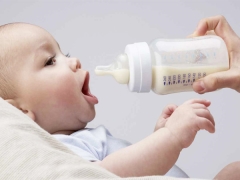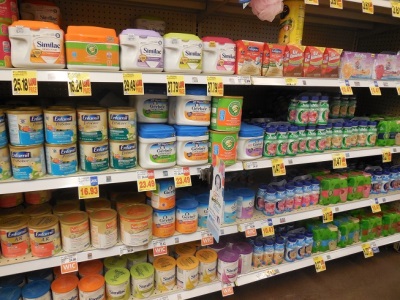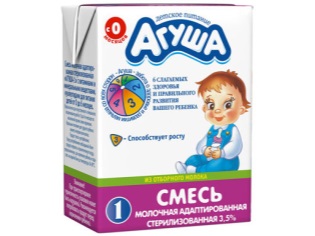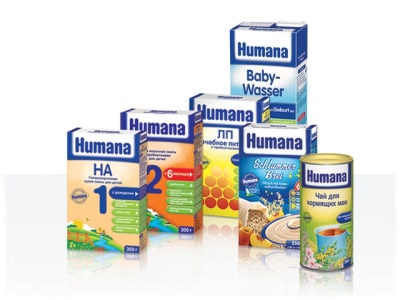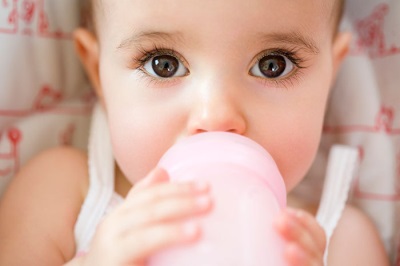Which mixture is better to choose?
Only mother is able to decide how to feed her child. And although breast-feeding It is considered the most suitable option, it happens when you have to feed the baby with a mixture. And then the task of the mother is to find the best kind of food for her baby.
When is the mix the only way out?
Breastfeeding is not possible in all life situations. Without mixtures can not do in such cases:
- If the baby was born much earlier than his term or he has problems with the nervous system, the consequence of which was the suppression of the sucking and swallowing reflex.
- If the crumb is in the hospital in the intensive care unit.
- If mother has serious illnesses, for example, oncological pathologies, tuberculosis and others.
- If the mother is forced to take medicines that get into the milk and are dangerous for the baby.
- When purging mastitis developed in a nursing mother.
- If several children were born and milk is insufficient for feeding them.
- If a woman does not support the idea of breastfeeding.
In many situations, when feeding a baby from the mother’s breast is impossible because of the immaturity or illness of the baby, the mother can give the expressed milk, not the mixture.
About, which is better: breast milk or mixtureread in another article.
Kinds
Children under one year of age are fed with both liquid and dry breast milk substitutes. Such substitutes can be fresh as well as fermented milk.
Most of the mixtures are made from cow's milk, which is subject to special treatment aimed at reducing the risk of allergic reactions and the maximum approximation of the chemical composition to breast milk.

Based on the adaptability of mixtures to breast milk, they are divided into the following types:
- Adapted. Their name indicates that they have maximum adaptability to human milk. Proteins in such foods are often whey and are absorbed by the body crumbs very easily. They contain the optimal amount of phosphorus and calcium, which are important for bone mineralization. Most of the mixtures of this type contain the amino acid taurine, which is necessary for the development of the brain and eyes. Some formulations include nucleotides that help shape the crumbs of the immune system. Examples are Nan, Nutrilon, Hipp, Frisolak, Bona, Heinz and others.
- Less adapted. Since the main protein here is casein, they are also called “casein formulas”. They are recommended for children who have a tendency to regurgitate. Since the nourishment of these mixtures is increased, they are the best choice for the crumbs who do not tolerate the breaks between feedings.
- Partially adapted. The composition resembles breast milk only partially, so their use is recommended for children older than two to three months of age. These include Kid, Detolact, Vitalakt M, Milumil, Baby and others.
- "Subsequent Formulas." So called mixtures intended for children older than six months, in some cases - over a year. They are characterized by increased energy value, suitable for the needs of children of this age.
In addition, infant formula is divided by the consistency:
- In the form of a dry powder that must be diluted before feeding in boiled water;
- In liquid form - they need to be heated before you give the child.
Milk-based mixtures that are fresh and fermented milk, which include various lactic and bifidobacteria, are isolated. Fermented milk mixtures are often prescribed to children with allergic reactions, dysbacteriosis, or simply with an unstable chair.
If the child is well tolerated selected mix, do not change it only on the advice of a friend. New food - stress for the child's body and a test of strength. Do not load the baby without the need for additional loads.
Types of therapeutic mixtures and indications for their reception
Only a doctor should prescribe a medical mixture to the child. They have strict indications, for example:
- If a baby has a deficiency of a lactose-splitting enzyme, it is recommended lactose free mixture.
- There are special mixes for babies who were born prematurely.
- For children who can not stand cow's milksoy blends are offered.
- Crumb, which is very difficult for food allergies and digestion processes are disturbed, half-element mixtures are shown.
- If a child has frequent regurgitations and vomiting, he is prescribed a mixture in which there are thickeners.

Brand overview and analysis
Choosing a suitable mixture for babies, it is important to pay attention to the composition of the product, taking into account the main components.
For a start, we note what ingredients are in the mixtures and why they are for a baby:
- Squirrels. As a rule, represented by the amount of 1.4 grams per 100 grams of product. In human milk, this indicator is slightly lower, because absorption is better.
- The ratio of whey proteins and casein. In breast milk, it is represented by the numbers from 80: 20 to 60: 40. It is this indicator that the mixture received by a baby under six months old should have. If the casein component is larger, it is called casein and is not considered highly adaptable.
- Taurine. This amino acid is important for the development of the nervous system of the baby, as well as vision. It is added to all mixes.
- Vegetable oils. To make the fatty component more similar to female milk, vegetable oil mixes are added to the products. There are controversies regarding palm oil, although this oil, like rapeseed oil, is permitted for feeding babies.
- Fatty acid. Among them, one of the vital important is linoleic. It is necessary for the retina and brain. This fatty acid is obtained from soybean, sunflower, coconut and corn oil. Equally important is the ratio of this fatty acid to linolenic. It should be no more than 7 to 1 - if there is more linoleic acid, it is unfavorable for the development of immunity, the heart and nervous system of the baby.
- Lactose. This carbohydrate is extremely important for babies, as it gives the baby's body energy, helps the absorption of calcium and iron, and is also needed for the development of beneficial microflora.
- Maltodextrin. A substance that belongs to carbohydrates and is also necessary for the development of bacteria in the intestines. Adding this ingredient makes the mixture more sweet and satisfying.
- Prebiotics. They are represented by fibers, oligosaccharides and lactulose, the pine influence of which is to regulate digestion.
- Probiotics. This is the name of microorganisms that are part of the organism, which stimulate the development of normal microflora in the intestine.
- Starch. It is important for the thickening of the food, so it is added to the mixture for babies who regurgitate a lot.
- Vitamin and mineral formula. The mixtures include all the important for the development of the crumbs of minerals and vitamins in larger quantities than they are presented in the milk of a woman, because they are absorbed much worse. When choosing, one should pay attention to the ratio of calcium to such a mineral as phosphorus. The optimal indicator is 2 to 1. The best ratio of sodium and potassium is 1 to 3, copper and iron are 1 to 20, zinc and iron are 1 to 2. But such a trace element like manganese should be less in baby formula, because excess can cause hyperactivity. Among the vitamins in the composition, special attention should be paid ascorbic acidwhich the baby of the first half of life should receive more than 30 mg per day.
- Nucleotides. These substances are important for the development of the baby, the formation of immunity and intestinal work.
- Choline. Such a substance is necessary for the nervous system of the crumbs.
Consider the particular composition of common mixtures:
Mix name | Benefits | disadvantages |
Similac Premium 1 |
|
|
Nestle Nestogen 1 |
|
|
Nestle NAN 1 Premium |
|
|
HiPP Combiotic 1 |
|
|
Nutricia Baby 1 |
|
|
Humana Expert 1 |
|
|
Baby Istra 1 |
|
|
Nutrilon Comfort Premium 1 |
|
|
Enfamil Premium LIPIL 1 |
|
|
Agusha GOLD 1 |
|
|
Friso Frisolac Gold 1 |
|
|
Semper BABY 1 |
|
|
MD Mil SP Goat 1 |
|
|
Bibicall Nanny 1 |
|
|
Nutrilak Premium 1 |
|
|
Lion Gold 1 |
|
|
A study comparing these mixtures and their safety, compliance with the composition written on the label, as well as ease of use, determined that all mixtures on the Russian market are safe for babies.
The best composition is determined by the mixture of the brand Humana, the worst - by the Kid Istra (less minerals, no nucleotides and omega fats).
If you compare the quality and price, the best ratio is different mix from the manufacturer HiPP.
Also, research has determined that the spoon in a jar is often inaccurate. The greatest deviation was revealed in a spoon attached to Agush mixtures.
The most accessible buyers are the mixtures of Agush, Baby, NAS, Nutrilak, Nutrilon, Nestozhen brands. They can be found in a large number of stores.
Inexpensive mixes are Baby, Nestozhen, Semper, Nutrilak, Similak.
Tips for choosing
Before purchasing a mixture, you must consult with your pediatrician watching your child, because the right choice affects the health of the baby. Fresh mixes are recommended immediately after birth, as regurgitation may increase from fermented milk products. From the second to the third month of life, 50% of the fresh mix can be replaced by fermented milk.

When purchasing an adapted mixture for your baby, you need to make sure that you can regularly buy the same product. Look at the mixes in stores and markets most in your area. Buy one of them and check the reaction of the baby, then buy it with a reserve, do not forget to check the integrity of its packaging and shelf life.
When choosing, be sure to read the composition and choose the best one for your baby. The can is more convenient than a cardboard box.
Choose a mixture, on the packaging of which it is written that the milk was taken from cows, in the feeding of which no antibiotics, hormones or other medicines were used.
We consider age
Since the digestive system and the need for substances change with age, the formula of the infant formula, like the composition of breast milk, depends on the age of the baby. Therefore, with age, the amount of unadapted milk proteins, vitamins and other trace elements increases. Mixtures with age are becoming more satisfying.
To understand the age at which the mixture is applied, can be as follows:
- The number "0" on the package (or the prefix "pre") - for children with low weight or premature babies;
- "1" - from birth to 6 months;
- "2" - from six months to a year;
- "3" - for a child older than a year.
Quantity calculation
If the crumbs are not yet 10 days old, To determine the volume of the mixture he needs per day, Finkelstein's formula is used. With a baby's weight less than 3200 g, his age in days is multiplied by 70, and with a greater weight - by 80.
For a baby older than 10 days, but younger than 2 months volume per day should be 1/5 of its weight.
Baby age two to four months should receive a day equal to 1/6 of its mass.
For a child of four to six months daily volume is 1/7 of its weight.
Baby older than six months approximately receives a mixture per day in a volume equal to 1 / 8-1 / 9 of its mass.
The resulting amount of the mixture is divided by the number of feedings.
Possible problems
You should certainly discuss such difficulties with a pediatrician:
- The child has an insufficient increase in height and weight.
- There were frequent regurgitations.
- The chair happens three times a day and more often. At the same time white undigested lumps are found in it.
- The baby has anxiety after feeding.
